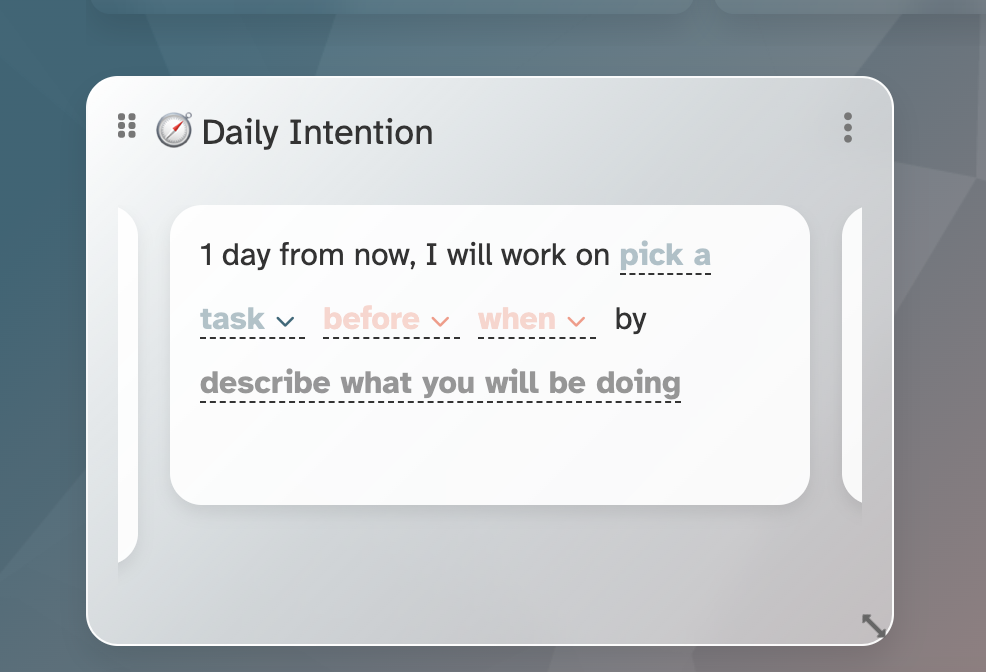Estimated reading time: 17 minutes
Implementation intentions, or If-Then statements, are a well researched approach to goal achievement. Whether supporting individuals with ADHD, other cognitive disabilities, or general goal attainment, setting intentions has been shown to support individuals in everything from automating behavior, enabling planning, and the use of them significantly increases the likelihood of achieving what you set out to do.
In personal development, implementation intentions act as a roadmap, transforming “I want to do” into real action. These intentions act as a guiding light, directing individuals towards plans that help motivate behavior. Setting intentions becomes a deliberate plan, creating commitment that empowers individuals to stay on track toward success.
Table of contents
- The Benefits of Implementation Intentions
- The Science Behind Implementation Intentions
- How’s It Work? Key Mechanisms
- The Psychological Aspect and Benefits of Implementation Intentions
- Creating Successful Implementation Intentions
- What Are the Steps of Implementation Intentions?
- Benefits of Implementation Intentions for Specific Groups
- Overcoming Procrastination with Implementation Intentions
- Implementation Intentions: Bridging Intentions to Actions
- Enhancing Daily Routines through Intention Setting
- Conclusion
The Benefits of Implementation Intentions
Implementation intentions play a vital role in enhancing goal attainment by bridging the intention-behavior gap and specifying the when, where, and how of goal-directed behavior. These intentions are powerful tools that help individuals translate their goals into action by providing clear plans for execution.
Intentions work by setting specific if-then plans that link situational cues with desired responses, we can significantly increase our chances of following through on our intentions.
One of the key advantages of implementation intentions is their ability to address self-regulatory problems. By creating structured plans that outline how to respond in various situations, individuals are better able to remember to act, seize opportunities, and overcome initial reluctance.
For instance, specifying ‘If I feel stressed after work, then I will go for a 10-minute walk in the park‘ can serve as a powerful reminder and strategy to manage stress effectively.
Research has shown that implementing specific plans for goal-directed behavior can lead to improved consistency and success. For example, in exercise, individuals who specify when and where they will work out are twice as likely to achieve their exercise goals compared to those without such specific plans.
This underscores the importance of implementation intentions in fostering adherence to desired behaviors.
The benefits of implementation intentions extend beyond just exercise goals. These structured plans have been found effective in various areas such as health behaviors, voting plans, and emotion regulation. By automating goal-directed behavior through specific plans, individuals can enhance their follow-through on a wide range of objectives.
Implementation intentions serve as a tried and true approach to accomplishing goals by providing a structured framework for goal-directed behavior. By setting clear plans and linking them to cues in the environment, individuals can significantly improve their chances of success across various domains of life.
The Science Behind Implementation Intentions
Understanding the science behind implementation intentions provides valuable insights into how this goal-setting strategy can significantly impact goal attainment rates. Research studies by Gollwitzer and Sheeran have shown that implementation intentions serve as a powerful tool in translating goal intentions into concrete actions.
By outlining the specific ‘when,’ ‘where,’ and ‘how’ of goal-directed behaviors in an if-then format, implementation intentions effectively bridge the intention-action gap, thereby boosting the likelihood of achieving desired goals.
How’s It Work? Key Mechanisms
The key mechanism behind implementation intentions’ success lies in the establishment of strong associative links between situational cues and corresponding actions. This process enhances the accessibility of relevant cues when it comes to executing the intended behavior, making it more likely for individuals to follow through on their goals.
The resulting automation of goal-directed behaviors solidifies the connection between intentions and actions, ultimately contributing to improved goal achievement across different contexts and demographic groups.
Mental Contrasting
The concept of mental contrasting, often used alongside implementation intentions, also plays a crucial role in enhancing goal attainment. Mental contrasting is the practice of comparing a desired future with the current reality. This helps people spot potential obstacles and plan ways to overcome them.
When combined with implementation intentions, mental contrasting can lead to even greater goal achievement by increasing motivation and focusing attention on the necessary actions.
The Psychological Aspect and Benefits of Implementation Intentions
The psychological aspect of implementation intentions cannot be overlooked. By creating a clear mental link between environmental cues and desired actions, individuals can prime themselves for success.
This mental rehearsal of if-then scenarios prepares individuals to respond automatically when faced with the specified cues, reducing the cognitive load associated with decision-making and increasing the likelihood of goal achievement.
Self-Regulation
Additionally, the concept of self-regulation plays a significant role in the success of implementation intentions. Self-regulatory processes, such as monitoring progress toward goals and adjusting behaviors accordingly, are facilitated by the implementation of if-then plans.
This self-regulation mechanism helps individuals stay on track, overcome obstacles, and maintain focus on their long-term objectives. Studies on this were particularly impactful for those with ADHD, where they found it supported impulse control and self-regulation.
Creating Successful Implementation Intentions
To effectively implement implementation intentions, individuals must identify self-regulatory challenges and craft specific if-then plans by specifying when, where, and how to act on a given goal.
Identifying obstacles, creating specific if-then plans, and setting clear goals all help individuals improve their chances of achieving their goals. The strategy of implementation intentions has been scientifically proven to double or even triple the chances for success by linking situational cues with effective responses.
Research in psychology emphasizes the significance of implementation intentions in behavior change. These plans act as pre-decisions that simplify the process of goal pursuit. When faced with challenges or distractions, having a predetermined if-then plan can steer individuals back on track, ensuring continued progress towards their objectives.
In creating intentions, it’s important to build on specificity. When we clearly outline the ‘when,’ ‘where,’ and ‘how’ of our intended actions, we create a concrete roadmap that minimizes ambiguity and maximizes clarity. This level of detail is part of what reduces the cognitive load associated with decision-making, making it easier to follow through.
Successful implementation intentions not only help in achieving personal and professional goals but also play a crucial role in habit formation and behavior modification. When individuals consistently apply the concept of if-then planning, they create a structure that reinforces positive habits and diminishes the impact of external distractions.
This consistent reinforcement builds resilience and strengthens the commitment to long-term objectives.
The concept of implementation intentions isn’t limited to any type of task – it can be applied in various aspects of life, including health and fitness goals, career advancements, and personal development. By tailoring if-then plans to specific situations and challenges, individuals can navigate obstacles more effectively and stay on course toward their desired outcomes.
Implementation intentions offer a useful framework for reaching goals, but it’s important to review and adjust them over time. Regularly checking how well if-then plans are working and making changes as needed helps keep progress steady and adaptable to any changes.
What Are the Steps of Implementation Intentions?
Step 1
To effectively apply ‘if-then’ plans in daily goal setting, individuals must begin by clearly defining their objectives. Breaking down these goals into smaller, manageable steps with specific behaviors and contexts is crucial. Asking ourselves, what are we trying to achieve?
If you are using a tool like Leantime, you will be able to use your broken down tasks to align into an intention.
Step 2
The next step involves formulating ‘if-then’ statements that outline when, where, and how you will take action towards your goals.

Leantime outlines their If-then statements like this and this is an easy template to use. Other models include more formal statements such as:
If X happens, then I will do Y.
We find this can be harder to apply to a variety of activities but it remains a tried and true approach if you are able to fit your activities into this.
Step 3
Consider the barriers. What could come up that might prevent you from achieving this? By anticipating challenges in advance, you can proactively devise specific if-then plans to overcome these hurdles. This proactive approach not only prepares individuals for setbacks but also empowers them to stay on course despite difficulties.
You can then follow these statements with a risk based if-then statement, “If X happens, then I will do Y.” This could look like: If I don’t get up in time to exercise before work, I will go to work at 4:30 on my way home.
Step 4
Keep track of your progress. Seeing your success will motivate you to keep going. This is what makes using tools to support implementation intentions so important. When you can see that you’re making progress towards your goals, it gets easier to stay on it.
General Tips for Success
Stay committed to the intentions. Here at Leantime, we view intentions as agreements and commitments that we’ve made with ourselves and what we see as important to complete for that day.
Use your intention to define success. Have you ever said anything like, “If I can just get these three things done, it was a successful day?” This can be hard when there is not always room for those three things in a single day. In such a case, it becomes more and more important to break down our activities into achievement and intentional activities.
Stay outcome and goal aligned. Intentions are intended to be commitments to goals or activities that result in an outcome. In the main image on this content, we describe the desire to learn to play the piano. Identifying that the desired outcome is learning the piano helps us set motivating achievements that make the intentions worthwhile.

Benefits of Implementation Intentions for Specific Groups
Tailoring implementation intentions for specific groups involves customizing if-then plans to address the unique challenges and needs of individuals with ADHD, diverse populations, and those with self-regulation difficulties. By linking situational cues with effective responses, implementation intentions can enhance goal attainment and overcome self-regulatory obstacles.
Research shows that tailoring implementation intentions has been effective in individuals with mental health issues like ADHD, improving cue accessibility, strengthening cue-response associations, and enhancing action control.
Benefits for Diverse Populations and an Opportunity to Support Diverse Needs
For Neurodivergent Individuals
For neurodivergent individuals, intention setting is crucial for navigating daily tasks and maintaining focus. Without clear intentions, it can be challenging to stay on track and complete important activities. By incorporating intention setting into their routines, neurodivergent individuals can create a structured approach to their day, leading to increased productivity and overall well-being.
Daily intention setting is a simple yet powerful practice that can positively impact our daily routines. Whether it’s enhancing productivity, improving sleep quality, or supporting neurodivergent individuals, setting intentions offers a pathway to a more structured, focused, and fulfilling life.
Ways to Support Cognitive and Mental Health Needs
Tailored implementation intentions for specific groups extend beyond mental health benefits; they foster a sense of structure, purpose, and proactive behavior. For individuals with ADHD, these tailored plans can mitigate impulsivity and improve task management.
In diverse populations, such as older adults or those with neurological conditions, customized implementation intentions serve as cognitive aids, enhancing cognitive functions and promoting independence. By customizing if-then plans to suit the unique needs of different groups, the efficacy of implementation intentions is maximized, leading to enhanced self-regulation, goal achievement, and overall well-being.
Implementation Intentions Support a Variety of Cognitive Needs
Implementation intentions has been studied for specific groups, attempting to understand and support the unique characteristics and challenges that each group faces. For individuals with ADHD, the tailored if-then plans can focus on reducing distractions, improving time management, and enhancing impulse control. By setting specific cues linked to desired responses, individuals can better navigate daily tasks and achieve long-term goals.
In diverse populations, customized implementation intentions can cater to the cognitive needs of older adults by simplifying task initiation and promoting memory retention.
Similarly, for individuals with neurological conditions, tailored plans can aid in maintaining focus, improving cognitive functions, and fostering independence in daily activities.
By incorporating personalized if-then plans into daily routines, individuals can establish a sense of predictability, reduce stress, and enhance overall well-being. Ultimately, though, it’s important to understand the goal and benefit of using a targeted approach of If-then plans.
Importance of Individualized Support and Inclusion
Implementation Intentions support a broader effort towards inclusion and the needs of a diverse work team. By enabling users to tailor intentions to their specific needs, an organization can highlight the importance and their interest in supporting and promoting positive outcomes. By leveraging the power of personalized implementation intentions, individuals can effectively navigate challenges, enhance self-regulation, and work towards achieving their aspirations with greater clarity and purpose. This is important for companies of all sizes to focus on and support.
Using Intentions to Improve Time Management
Implementation intentions not only aid in achieving personal goals but also have broader applications in various aspects of life. One significant area where implementation intentions are highly beneficial is in managing time effectively. By setting specific ‘if-then’ plans for how to allocate time for tasks and activities, individuals can enhance their productivity and efficiency.
For instance, an individual aiming to improve their time management skills can create implementation intentions like ‘If it’s 9 a.m., then I will start working on the project’ to establish a clear schedule and commitment to task completion.
The Broader Implications of If-Then Plans
When considering the broader implications of implementation intentions, it is evident that the strategy not only improves individual performance but also fosters a culture of accountability and achievement within organizations. By encouraging a proactive approach to goal setting and task execution, businesses can better cultivate a motivated workforce that consistently strives for excellence and drives collective success.
Organizational Performance and Impact
The impact of implementation intentions goes beyond the individual level, extending its benefits to organizational performance. When implemented in a workplace setting, these if-then plans can revolutionize how tasks are approached and completed. By breaking down complex projects into specific if-then steps, employees can navigate through their work with increased efficiency and effectiveness. This approach not only streamlines processes but also enhances overall team productivity.
Application in Education
Moreover, the use of implementation intentions in educational settings has shown promising results. Students who employ implementation intentions for academic tasks exhibit higher levels of engagement, persistence, and achievement. By incorporating these planning strategies into learning environments, educators can support students in developing effective study habits and reaching their academic potential.

Overcoming Procrastination with Implementation Intentions
Procrastination is a common challenge that we all face for a slew of reasons. By utilizing implementation intentions, individuals can effectively combat procrastination and start to make significant progress towards our goals. Implementation intentions involve setting specific intentions structured around ‘if-then’ statements.
For example, one can create a statement like, ‘If it is 9 a.m. And I am at my desk, then I will start working on the project.’ By formulating such precise intentions, individuals establish a clear path forward and break down tasks into manageable steps.
It is important to include specific details such as time, place, and action in these intentions to avoid vague timeframes. By incorporating concrete cues related to the environment, individuals can develop new habits and tackle procrastination more efficiently. The key to success lies in acting upon these intentions regardless of one’s current mood. This approach emphasizes that action can be taken even when motivation is lacking.
Acknowledging that action can be independent of mood empowers individuals to make consistent progress toward their objectives. This shift in mindset helps overcome procrastination.
When implementing implementation intentions, we not only set ourselves up for immediate action but also start to establish a framework for long-term habit formation. Research in psychology has shown that the ‘if-then’ planning strategy significantly increases the likelihood of following through on intentions. This method capitalizes on the power of situational cues to prompt behavior, making it easier to overcome the inertia associated with procrastination.
In addition to enhancing productivity, the practice of implementation intentions fosters a sense of self-efficacy and control over one’s actions. By consistently aligning behavior with predefined cues, individuals reinforce their belief in their ability to follow through on commitments. This reinforcement loop strengthens their resolve to tackle challenging tasks, leading to an overall improvement in performance and goal attainment.
Implementation intentions offer a practical and evidence-based approach to overcoming procrastination and enhancing goal pursuit. By leveraging the power of specific intentions and environmental cues, individuals can cultivate a proactive mindset that prioritizes action over avoidance.
Embracing this strategy not only facilitates task initiation but also cultivates a habit of persistence and resilience in the face of procrastination. Through deliberate practice and commitment to implementing intentions, individuals can transform their approach to productivity and achieve greater success in both personal and professional endeavors.
Implementation Intentions: Bridging Intentions to Actions
Implementation intentions are a powerful psychological strategy that has been extensively studied in various fields. Research findings consistently demonstrate their effectiveness in bridging the intention-behavior gap, leading to improved goal attainment.
These intentions have shown remarkable success in diverse areas such as exercise adherence, healthy eating habits, ethical consumer choices, and more. Particularly noteworthy is their positive impact on individuals facing mental health challenges, neurological disorders, and difficulties in self-regulation.
Automating Action Initiation
One of the key strengths of implementation intentions lies in their ability to automate the initiation of actions. By explicitly planning ‘if-then’ scenarios, individuals enhance their attention and memory, facilitating the execution of desired behaviors. Moreover, these intentions can help override ingrained habits and stereotypes, paving the way for positive changes.
Achievements and Impact
Studies have highlighted the significant achievements enabled by implementation intentions. They have proven effective in boosting voter turnout rates, increasing flu vaccination uptake, aiding in weight loss efforts, and promoting overall health-related behaviors. The cognitive mechanisms that underlie the success of implementation intentions include the accessibility of cues, the formation of cue-response associations, and the enhancement of action control efficiency.
Time and event cues are an important part of this as we discuss in Leantime’s application. As you find yourself sitting at your desk after breakfast, the “after breakfast” part serves as an cue to signal what you have committed to work on and when.
Future Directions
While the existing research provides valuable insights into the benefits of implementation intentions, further investigations are warranted. Future studies should delve into the physiological underpinnings of these intentions and explore their applicability across diverse populations and contexts.
Expanding our understanding of the mechanisms and potential of implementation intentions can help us harness their power more effectively to foster positive behavioral changes.
Long-Term Effects and Adaptability
Research exploring the long-term effects of implementation intentions suggests that these plans not only impact immediate behaviors but also have lasting influences. By establishing specific cues and responses, individuals can create enduring habits that lead to sustained positive outcomes.
Plus, the versatility of implementation intentions allows for their adaptation to various situations and goals, making them a flexible and customizable tool for behavior change.
Cognitive Load Reduction
Moreover, implementation intentions serve as a cognitive tool that helps individuals automate decision-making processes. By pre-determining responses to specific situations, individuals reduce the cognitive load involved in initiating tasks, making it easier to transition from intention to action. This cognitive offloading effect frees up mental resources that can be redirected towards executing the planned activities effectively.
This is really important as our lives continue to get busier and more robust in the demands placed on us. With some studies identifying that we make an average of 35,000 decisions per day, anything we can do to reduce the cognitive load becomes significant.
Enhancing Daily Routines through Intention Setting
Leantime Platform Integration
Leantime, a platform that incorporates daily intention setting, offers a practical solution for individuals looking to establish and maintain daily routines. For those seeking to leverage the power of implementation intentions, tools like Leantime’s daily intention-setting feature can be invaluable.

Leantime structures their if-then statements a little differently so that it works with the tasks that you already have in the system. Selecting the task, you can then note the time frame or time trigger that you will complete the task and then takes it a step further by allowing you to describe how you will start the work on the activity.
This approach gives you an intentional commitment statement, a time trigger (breakfast, lunch, etc), and then the first steps that you need to take. These items all work together to further enhance the benefits of if-then plans.
The system also intends for users to set up their intentions as part of their nightly routine. Research has found that individuals who plan for their next day tasks prior to bed fall asleep faster than those who journal or use other tools.
Conclusion
Implementation intentions have proven to be a tried and true approach to accomplishing goals. By clearly outlining the specific steps needed to reach a goal and anticipating obstacles that may arise, individuals can increase their chances of success.
Research has shown that implementation intentions can help individuals stay focused, motivated, and disciplined in pursuing their objectives. Therefore, incorporating implementation intentions into goal-setting strategies can be a powerful tool for achieving desired outcomes.
Other readings you may be interested in:






